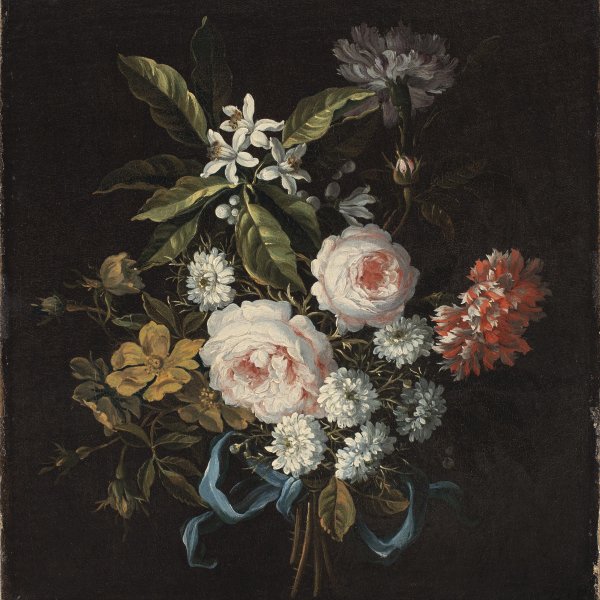Jean-Baptiste Monnoyer
Lille, 1636-Londres, 1699
Monnoyer was a French artist who specialised with great success in flowers and fruit pieces, although he also worked on historical and landscape painting. Little is known of his training, although he seems to have studied in the Flemish town of Antwerp. There he came across the works of Davidsz de Heem, Fyt and Hieronymus Galle. Towards 1650 he was documented in Paris, working at the Hôtel Lambert. Among his first decorations with flowers are those of the Hôtel Lauzun in Anjou. From 1658 he was associated with the team working for Le Brun, the artist's patron. Among the royal residences he helped decorate are: Vincennes, the queen's apartments, carried out under the supervision of Philippe de Champaigne; the Château de Saint-Cloud, for the king's brother, Philip of Orleans; Versailles; Marly and the Tuileries. In 1665, partly due to the success of his art, he became a member of the Academy, and was appointed Counsellor in 1679. From 1666 he collaborated assiduously with the Gobelins, designing wreaths and borders for tapestries together with his brother-in-law Jean-Baptiste Belin, and with the Beauvais manufacturers, working with Jean Bérain. In 1690, in spite of the good clientele he had in France, he travelled to London to attend to the decoration of Ralph Montagu's residence (British Museum). Two years later he returned to London, producing paintings for Burlington House (Charles Howard), Kensington Palace (Charles Beauclerk) and Hampton Court. He spent the last two years of his life in England; he died in London on 20 February 1699.
His still lifes are characterised by the magnificence and brilliance of the colours of his flowers, placed in luxurious vases and containers, the varieties of which are chosen, to be included in the bouquet, for their particular shape and colour. In the background, which is sometimes architectural, he places elegant tapestries occasionally including animals. Among his followers are two of his sons: Antoine and Baptiste. Throughout his life he collaborated with many artists such as René-Antoine Houasse, Hyacinthe Rigaud and Jean-Baptiste Blin de Fontenay. His paintings were greatly appreciated in his time as well as in the 18th century, and were included in many collections; Louis XIV owned around sixty. He was a considerably productive painter, and attained fame and success in his lifetime, which provided him with a good clientele. His work is well represented in museums such as the Palace of Versailles, the Grand Trianon, the Musée du Louvre and the Musées des Beaux Arts in Lille, Orléans and Valenciennes, among others. The series of engravings reproducing his still lifes contributed to spread and popularise his work.
Mar Borobia
His still lifes are characterised by the magnificence and brilliance of the colours of his flowers, placed in luxurious vases and containers, the varieties of which are chosen, to be included in the bouquet, for their particular shape and colour. In the background, which is sometimes architectural, he places elegant tapestries occasionally including animals. Among his followers are two of his sons: Antoine and Baptiste. Throughout his life he collaborated with many artists such as René-Antoine Houasse, Hyacinthe Rigaud and Jean-Baptiste Blin de Fontenay. His paintings were greatly appreciated in his time as well as in the 18th century, and were included in many collections; Louis XIV owned around sixty. He was a considerably productive painter, and attained fame and success in his lifetime, which provided him with a good clientele. His work is well represented in museums such as the Palace of Versailles, the Grand Trianon, the Musée du Louvre and the Musées des Beaux Arts in Lille, Orléans and Valenciennes, among others. The series of engravings reproducing his still lifes contributed to spread and popularise his work.
Mar Borobia






